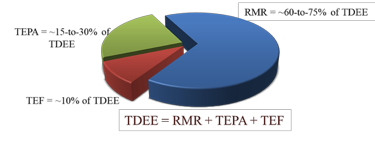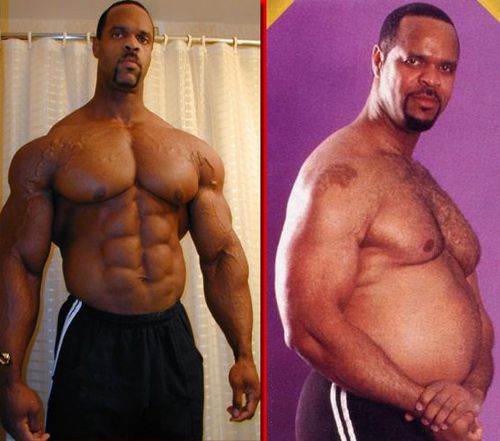WHAT IS RESTING METABOLIC RATE? (BMR/RMR)
- Resting metabolic rate-BMR or BMR (Basal Metabolic Rate) is the total number of calories burned when your body is completely at rest.
- RMR supports breathing, circulating blood, organ functions, and basic neurological functions.
- It is proportional to lean body mass and decreases approximately 0.01 kcal/min for each 1% increase in body fatness.
USE BMR ONLINE CALCULATOR HERE
Mention the term ‘metabolism’ and it captures attention given how obsessed many of us have become over calories. As a certified personal trainer, this is a topic you may get asked about from time to time.
Contents
To the general public, boosting your metabolism is associated with the transformation from ‘fat-to-fit’ or ‘flab-to-fab’. This is an outcome of enhanced caloric expenditure, increased lean body mass, greater fat utilization and overall weight loss.
Our resting metabolic rate (RMR) plays a significant role in this, and it’s understandable why it garners so much attention. But before we dive into RMR, let’s take a look at the components of total daily energy expenditure (TDEE).
TOTAL DAILY ENERGY EXPENDITURE (TDEE)
Scientific references to metabolism refer to the bodily processes needed to maintain life. But for most of us, it refers to total daily energy expenditure and how it influences our energy in versus energy out equation.
Our TDEE is essentially comprised of 3 components:

- Resting metabolic rate (RMR): the energy required to keep your body functioning at rest
- The thermic effect of food (TEF): the energy cost of chewing, swallowing, digesting, absorbing and storing food
- The thermic effect of physical activity (TEPA): the energy of activity (e.g., exercise, physical activity) and non-exercise activity thermogenesis (NEAT).*
* Non-exercise Activity Thermogenesis: Energy expended for everything you do that does not include sleeping, eating, physical activity or exercise – ranges from simple standing to fidgeting and moving about. NEAT shouldn’t be confused with METS (Metabolic equivalents are defined as caloric consumption (by means of breathing) of an active individual compared with their resting basal metabolic rate.)

CALCULATING RMR
1.CALORIMETRY
- Direct calorimetry measures the amount of heat produced by a subject enclosed within a small chamber to calculate energy expenditure.
- Indirect calorimetry measures oxygen utilization rates via gas analysis to calculate energy expenditure.
Although direct and indirect calorimetry provide accurate estimates of RMR, these techniques are expensive, time consuming and difficult to access. As a result, more accessible and affordable techniques that estimate RMR have been developed over the past 100 years. They measure this value with varying degrees of accuracy.
The most common methods utilized today are mathematical formulas. You can access these with calorie calculators on the Internet, an app or through wearable devices.
Here’s an example of one online calculator you can use to find out your RMR:
2.Online Calorie Calculator
3.HARRIS AND BENEDICT EQUATION
- The Harris and Benedict (H&B) equation created in 1918 and amended in 1984 remains widely used today
- While it was intended to measure basal metabolic rate (BMR) or basal energy expenditure (BEE), they are used interchangeably with RMR.
- Technically, BMR measures energy expenditure in a darkened room (reclining position) after eight hours of sleep and following a 12-hour fast whereas RMR measurements are less restrictive and reflect the body’s resting energy expenditure after an overnight fast.
The revised H&B equations for males and females are:
Men: 88.362 + (13.397 × weight in kg) + (4.799 × height in cm) – (5.677 × age in years)
Women: 447.593 + (9.247 × weight in kg) + (3.098 × height in cm) – (4.330 × age in years)
As an example, for a 38-year old female, who stands 5’6” (167.6 cm) and weighs 145 pounds (65.9 kg), her BMR or RMR would equal approximately 1,411 calories. This is the energy needed daily to maintain normal physiological function.
4.MIFFLIN-ST JEOR FORMULA
The Mifflin-St Jeor formula, created in the 1990s, provided an alternative and more valid estimate of RMR
The equations for males and females are:
Men: (10 × weight in kg) + (6.25 × height in cm) – (5 × age in years) + 5
Women: (10 × weight in kg) + (6.25 × height in cm) – (5 × age in years) – 161
Using that same example and this equation, the female’s RMR would equal approximately 1,356 calories.
POTENTIAL ERRORS
- At first, this error appears small (i.e., 55 calories), but extrapolated over a one-year period, it amounts to almost six pounds of energy or body weight.
- Furthermore, these formulas also imply that all individuals of the same gender, age, height and weight have the same RMR, a fact that is certainly not accurate. Your lean body mass will significantly influence RMR and should always be considered.
- Although the Katch-McArdle and Cunningham formulas are derived from lean body mass rather than total body weight, they rely upon an accurate measurement on lean body mass.
- The errors of these formulas can be quite significant – studies have demonstrated accuracy within 10% of true RMR (Mifflin St Jeor) to as high as 36% error in obese individuals (H&B) (4-5).
Factors that affect BMR OR RMR
Age, genetics and even biological adaptations are just a few non-controllable events.
1.AGE
For example, age-related reductions in our resting metabolic rate (RMR) can decrease by approximately 2% per decade after peak growth is attained (late teens for females, early 20’s for men) (6).
Considering how RMR contributes around 60-to-75% of TDEE, in practical terms this equals approximately 25-to-30 calories per day for the average adult or 2½-to-3 pounds (1.1-1.4 Kg) per year.
2.GENETICS AND EPIGENETICS
- Genetics and epigenetics can also play a significant role. Over 100 different genes have been identified by scientists that are related to obesity.
- The fat mass and obesity-associated gene, the FTO gene, can cause people to overeat due to low satiety
- Eating behaviors associated with a low satiety include eating larger portions, preferring calorie-dense foods high in fat and sugar, enjoying palatable foods like appetizers and snacks, and snacking more frequently.
- This FTO gene can also alter RMR by up to 160 calories per day – this amounts to almost 17 pounds (7.5 Kg) over the span of a year.
- Epigenetics is the field of study that examines inheritable changes within our genetic expression that occurs without change to our underlying DNA sequence.
- It is both a regular and natural occurrence and is influenced by age, environment, diet, geographical location, lifestyle and disease.
CONTROLLABLE RMR FACTORS
This list is potentially endless, but the reality is that most fitness professionals usually limit their strategies to exercise, macronutrients, calories and various stimulants.
1.STIMULANTS
For example, evidence supports a temporary thermogenic-boosting effect by 4-to-5% with edibles like caffeine and capsaicin that can amount to approximately 15-to-25 calories in a day (9).
2.LEAN BODY MASS
Building lean body mass is another effective method for boosting RMR. Peak muscle mass in humans usually occurs at ages 28-to-32 after which muscle losses begin to occur.
3.SLEEP
It might interest you to know that even a lack of sleep (i.e., sleep debt) can negatively impact your RMR.
4.LOW CALORIC INTAKE
Thirty years of research demonstrates how the practice of eating very low caloric intakes (e.g., starvation, 800-calorie diets) can suppress RMR, a number that by some estimates can be as high as 20%.



